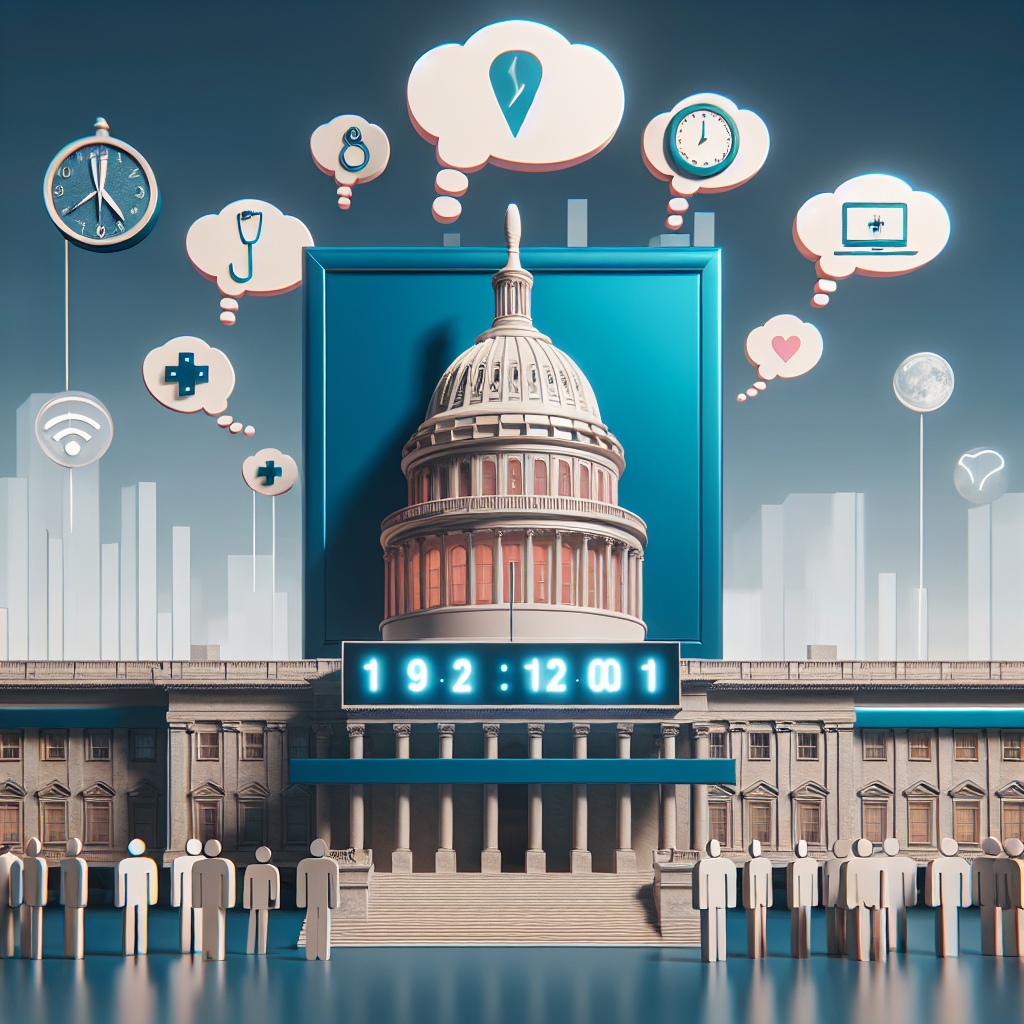Congress Urges DEA to Extend Telehealth Flexibilities as Year-End Deadline Approaches

As the year-end deadline looms, Congress is urging the Drug Enforcement Administration (DEA) to extend telehealth flexibilities that were initially introduced during the COVID-19 pandemic. These flexibilities have played a crucial role in ensuring continued access to healthcare services, particularly for those in remote or underserved areas. This article delves into the significance of these telehealth flexibilities, the potential impact of their expiration, and the ongoing debate surrounding their extension.
The Evolution of Telehealth During the Pandemic
The COVID-19 pandemic has been a catalyst for change in many sectors, with healthcare being one of the most significantly impacted. The rapid spread of the virus necessitated a shift in how healthcare services were delivered, leading to an unprecedented rise in telehealth services. This section explores the evolution of telehealth during the pandemic and the role of DEA’s flexibilities in this transformation.
Before the pandemic, telehealth was a growing but still relatively niche service. Regulatory barriers, technological limitations, and a lack of widespread adoption by healthcare providers and patients alike limited its reach. However, the onset of COVID-19 changed this landscape dramatically. With social distancing measures and lockdowns in place, telehealth became a vital tool for maintaining healthcare access.
The DEA played a pivotal role in this transformation by temporarily relaxing certain regulations. These flexibilities allowed healthcare providers to prescribe controlled substances via telehealth without an in-person consultation, a significant departure from pre-pandemic rules. This change was crucial for patients requiring ongoing treatment for chronic conditions, mental health issues, and substance use disorders.
Statistics from the Centers for Medicare & Medicaid Services (CMS) highlight the surge in telehealth usage. In April 2020, over 43% of Medicare primary care visits were conducted via telehealth, compared to just 0.1% in February 2020. This dramatic increase underscores the importance of telehealth in maintaining healthcare continuity during the pandemic.
- Telehealth adoption surged due to necessity during COVID-19.
- DEA’s regulatory flexibilities were crucial for telehealth expansion.
- Telehealth became essential for chronic and mental health care.
The Role of DEA Flexibilities in Expanding Access
The DEA’s decision to relax certain regulations was instrumental in expanding access to healthcare services during the pandemic. This section examines the specific flexibilities introduced by the DEA, their impact on healthcare delivery, and the potential consequences of their expiration.
One of the most significant changes was the waiver of the Ryan Haight Act’s requirement for an in-person medical evaluation before prescribing controlled substances via telehealth. This waiver allowed healthcare providers to reach patients who were unable or unwilling to attend in-person appointments due to COVID-19 risks.
These flexibilities were particularly beneficial for patients with mental health conditions and substance use disorders. The ability to prescribe medications like buprenorphine for opioid use disorder via telehealth was a game-changer, enabling patients to continue their treatment without interruption. According to a study published in JAMA Psychiatry, the use of telehealth for mental health services increased by 556% during the pandemic.
However, the potential expiration of these flexibilities raises concerns about access to care. Without the ability to prescribe controlled substances via telehealth, many patients may face barriers to receiving necessary treatment. This is particularly concerning for those in rural or underserved areas, where healthcare providers may be scarce.
- DEA’s waiver of in-person evaluation requirements was crucial.
- Telehealth facilitated continued treatment for mental health and substance use disorders.
- Expiration of flexibilities could hinder access to necessary care.
The Debate Over Extending Telehealth Flexibilities
The debate over whether to extend telehealth flexibilities is multifaceted, involving considerations of patient safety, access to care, and regulatory oversight. This section explores the arguments for and against extending these flexibilities and the potential implications for the healthcare system.
Proponents of extending telehealth flexibilities argue that they have been instrumental in expanding access to care, particularly for vulnerable populations. They contend that the benefits of increased access outweigh potential risks, and that telehealth has proven to be a safe and effective mode of healthcare delivery. A survey conducted by the American Medical Association found that 85% of physicians believe telehealth has improved the timeliness of care.
On the other hand, opponents raise concerns about the potential for misuse and diversion of controlled substances. They argue that in-person evaluations are necessary to ensure patient safety and prevent abuse. The DEA has expressed concerns about the potential for telehealth to be used as a means to obtain controlled substances without proper oversight.
The debate also touches on broader issues of healthcare equity and access. Telehealth has the potential to bridge gaps in access to care, but only if it is implemented in a way that addresses disparities in technology access and digital literacy. Ensuring that all patients can benefit from telehealth services is a key consideration in the ongoing debate.
- Proponents highlight increased access and timeliness of care.
- Opponents raise concerns about misuse and patient safety.
- Equity and access are central to the telehealth debate.
Case Studies: Telehealth Success Stories
To better understand the impact of telehealth flexibilities, it is helpful to examine real-world examples of how these changes have benefited patients and healthcare providers. This section presents case studies that illustrate the positive outcomes of telehealth during the pandemic.
One notable example is the use of telehealth in rural communities. In areas where healthcare providers are scarce, telehealth has enabled patients to access specialists and receive timely care. A study by the National Rural Health Association found that telehealth reduced travel time and costs for patients, leading to improved health outcomes.
Another success story comes from mental health services. The increased availability of telehealth has allowed mental health providers to reach more patients, particularly those who may have been hesitant to seek in-person care. A report by the National Alliance on Mental Illness found that telehealth reduced barriers to mental health treatment, leading to increased engagement and better outcomes.
These case studies highlight the transformative potential of telehealth and underscore the importance of maintaining the flexibilities that have enabled its growth. By examining these success stories, we can better understand the value of telehealth and the need for continued support from policymakers.
- Telehealth has improved access in rural communities.
- Mental health services have seen increased engagement through telehealth.
- Case studies demonstrate the positive impact of telehealth flexibilities.
The Path Forward: Policy Recommendations and Future Considerations
As the deadline for extending telehealth flexibilities approaches, policymakers must consider the best path forward. This section offers policy recommendations and future considerations for ensuring that telehealth remains a viable and effective mode of healthcare delivery.
One key recommendation is to make certain telehealth flexibilities permanent. This includes allowing the prescription of controlled substances via telehealth under specific conditions, such as for patients with established provider relationships. By codifying these changes, policymakers can provide certainty for healthcare providers and patients alike.
Another important consideration is addressing disparities in access to technology and digital literacy. Ensuring that all patients can benefit from telehealth services requires investment in broadband infrastructure and digital literacy programs. Policymakers should prioritize these efforts to ensure equitable access to telehealth.
Finally, ongoing evaluation and oversight are essential to ensure the safe and effective use of telehealth. This includes monitoring for potential misuse and ensuring that telehealth services meet quality standards. By implementing robust oversight mechanisms, policymakers can address concerns about patient safety while maintaining the benefits of telehealth.
- Consider making certain telehealth flexibilities permanent.
- Address disparities in technology access and digital literacy.
- Implement robust oversight mechanisms for telehealth services.
Conclusion
As the year-end deadline for telehealth flexibilities approaches, Congress and the DEA face critical decisions about the future of telehealth. The flexibilities introduced during the pandemic have been instrumental in expanding access to care and improving health outcomes. However, their potential expiration raises concerns about access and equity.
By examining the evolution of telehealth, the role of DEA flexibilities, and the ongoing debate over their extension, this article has highlighted the importance of maintaining support for telehealth services. Through thoughtful policy recommendations and a commitment to addressing disparities, policymakers can ensure that telehealth remains a vital component of the healthcare system.
Ultimately, the path forward requires balancing the benefits of increased access with the need for patient safety and regulatory oversight. By doing so, we can build on the successes of telehealth during the pandemic and create a more equitable and accessible healthcare system for all.





